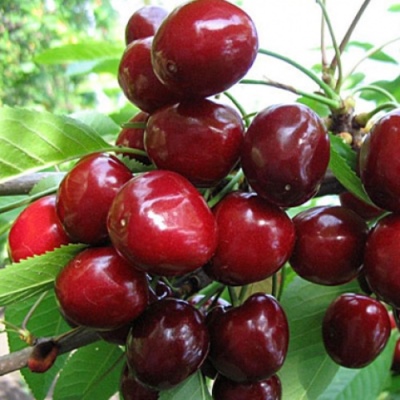
- Fruit shape: blunt-hearted, with a wide funnel and slightly pointed apex
- Authors: A.A. Astakhov, M.V. Kanshina, L.I. Zueva (All-Russian Research Institute of Lupine)
- Year of approval: 2009
- Growth type: medium-sized
- Appointment: universal
- Yield: high
- Crown: pyramidal, rounded-oval, raised, of medium density
- Escapes: medium, straight, horizontal, gray
- Sheet: medium, obovate, green, matte, hairless, leathery, boat-curved, pointed
- Fruit size: large
Lena is a universal sweet cherry variety, bred by specialists from the All-Russian Research Institute of Lupine. Approved for use in 2009. And although the variety has been used for a little over 10 years, its features have been well studied by gardeners.
Description of the variety
The Lena variety is characterized by the following external characteristics:
- tree of medium vigor, has a rounded-oval raised crown in the form of a pyramid;
- shoots are medium in size, grow horizontally relative to the trunk, gray with burgundy tint;
- the kidneys are located at a certain angle;
- green leaves with white-gray pronounced veins, oval, pointed on one side, wavy along the edge
- one side of the sheet plate is glossy, the other is rough with a light pile;
- flowers are saucer-shaped, large, umbrella type, in inflorescences 3-6 flowers are formed, they are formed on bouquet branches.
Fruit characteristics
The berries are large, weighing 6-8 g, develop in the form of a blunt heart with a wide funnel and a weakly pointed tip. The skin of the fruit is black-red, there are few subcutaneous points.
Taste qualities
Cherry Lena is recommended to be consumed fresh, as this is the only way to feel the tenderness of its skin and juicy dense pulp. The berries are sweet-sour in taste, rated at 4.7 points, and another advantage is the good separation of the bone from the pulp. The berries contain a large amount of dry matter and ascorbic acid. Meanwhile, the fruits are perfect for making juices, compotes and preserves, or as a filling for pies.
Ripening and fruiting
The first berries appear 4 years after planting. Lena belongs to varieties with a late ripening period, that is, the first fruits can be eaten not earlier than the end of July.

Yield
This is a high-yielding variety, which gives an average of 80 c / g, and the maximum yield is 121 c / ha.
Self-fertility and the need for pollinators
The Lena variety cannot pollinate on its own, so it needs pollinating neighbors, that is, trees with the same ripening period. Suitable, for example, Revna, Tyutchevka, Iput, Ovstuzhenka.
Growing and care
The cultivation of the presented variety is recommended in the Central regions of Russia. Care includes watering, feeding, pruning, disease treatment and frost protection. Let us dwell on several points in more detail.
- Watering.
It is a moisture-loving variety that nevertheless does not tolerate stagnant water, so plant the plant in an area with deep groundwater. In summer, the tree is watered 3-4 times, after each procedure, the trunk circle is loosened. This is to prevent the formation of a crust, which can lead to a lack of oxygen.
- Preparing for winter.
The Lena variety belongs to the winter-hardy varieties, but it needs help to survive the harsh time. So, at the beginning of autumn, add phosphorus-potassium fertilizing, and before the onset of frost, pour abundantly water on the near-trunk circle.After leaf fall, collect all the leaves and destroy, since various insects can settle in them for the winter.




Disease and pest resistance
The Lena variety has excellent immunity against such common ailments as moniliosis or clasterosporiosis, but sometimes it can be affected by fungal diseases.
To avoid this, do not overflow, during pruning, process all sections with garden pitch and remove the carrion in a timely manner. Treat periodically with special agents, for example, Bordeaux liquid or copper sulfate.


Review overview
Among the advantages of the Lena variety, gardeners note high yields, disease resistance and excellent fruit taste. Among the shortcomings, summer residents call the need for pollinators, as well as the possible freezing of a young seedling, despite the good winter hardiness indicated by the manufacturers. That is, in the first year, it is recommended to cover the tree with protective materials for the winter.































































